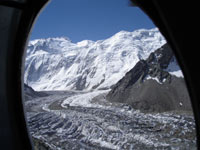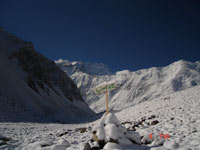
Communism Peak and Korzhenevskaya Peak expedition, Ismoil Somoni Peak
Восхождение на пики Коммунизма и Корженевской
Communism (Ismoil Somoni) Peak (7495 m) and Korzhenevskaya (7105 m) Peak expedition. Mountaineering program 2026. Packages.
Price – 3900 U$/pax / 3500 U$/pax / 2700 U$/pax Supplier of services: ClimberCA International Consortium. About Us
Price of optimal package includes: Price of economical package includes: Prices does not include: Additional service in BC Guides Porters: For further information and to booking please contact us via
Ismoil Somoni Peak (Communism Peak) satellite informationnIsmoil Somoni Peak (Communism Peak) is the highest mountain in Tajikistan and in the former Soviet Union (elevation 7,495 m, prominence 3,402 m Coordinates 38°55’00”N 72°01’00”E), recently named after Ismoil Somoni, the ancestor of the Samanid dynasty. When the existence of a peak in the Soviet Pamir Mountains higher than Lenin Peak (now called Ibn Sina Peak) was first established in 1928, the mountain was tentatively identified with Garmo Peak; but as the result of the work of further Soviet expeditions, it became clear by 1932 that they were not the same, and in 1933 the new peak, from the Akademiya Nauk Range, was named Stalin Peak, after Joseph Stalin. In 1962, the name was changed to Communism Peak, and in 1998 to its current name. The first ascent was made in 1933 by the Soviet mountaineer Yevgeniy Abalakov. Peak Korzhenevskaya satellite informationPeak Korzhenevskaya is the third highest peak (elevation 7,105 m, prominence 1,650 m) in the Pamir Mountains of Tajikistan. It is one of the five “Snow Leopard Peaks” in the territory of the former Soviet Union. It is named after Evgenia Korzhenevskaya, the wife of Russian geographer Nikolai L. Korzhenevskiy, who discovered the peak in August 1910. Due to transliteration and declension issues the peak’s name is rendered in many different ways, including Korzhenevski, Korzhenevskoi, and Korzhenievsky. Peak Korzhenevskaya lies about 13 km (8 mi) north of Ismoil Somoni Peak (formerly Communism Peak), the highest point of the Pamirs in the territory of the former Soviet Union. It forms the end of the northwest fork of the Akademiya Nauk Range, the north-south trending subrange which forms the core of the Pamirs. It rises on the south bank of the Muksu River, and to the west of the peak is the Fortambek Glacier. While most of the Akademiya Nauk Range is in Tajikistan’s Gorno-Badakhshan Autonomous Province (GBAO), Peak Korzhenevskaya is located a little to the west of the GBAO line, in Jirgatol district (Region of Republican Subordination). Peak Korzhenevskaya is one of the five 7,000 m peaks of the former Soviet Union (this counts Khan Tengri, which is more often given as 6,995 m) that were required for a climber to be awarded the Snow Leopard award, the highest honor given to Soviet mountaineers. It is usually said to be the second easiest of these peaks to climb, after Lenin Peak. However it is not a easy mountain; its rise above local terrain rivals that of Ismoil Somoni Peak, since it is closer to the deep valley of the Muksu River. In 1937 D. Gushchin led an attempt on the peak which reached the lower summit (6,910 m). Korzhenevskaya was first climbed in 1953 by a party led by A. Ugarov; the summit team comprised Ugarov, B. Dimitriev, A. Goziev, A. Kovyrkov, L. Krasavin, E. Ryspajev, R. Sielidzanov, and P. Skorobogatov. They approached via the Fortambek Glacier, to the Korzhenevsky glacier, and thence to the north ridge. Partly since it is required for the Snow Leopard award, Peak Korzhenevskaya has been climbed many times; it is the second most frequented major peak in the Pamirs, after Lenin Peak. A base camp on the moraine of the Moskvin Glacier, and helicopter access, make this possible. Peak Korzhenevskaya has been climbed from almost every direction, including a first winter ascent in 1986; most of these ascents were by Russians. The most common current route on the mountain ascends from the south and attains the summit ridge from the west side. Sources: |
|||||||||||||||||||||||||









